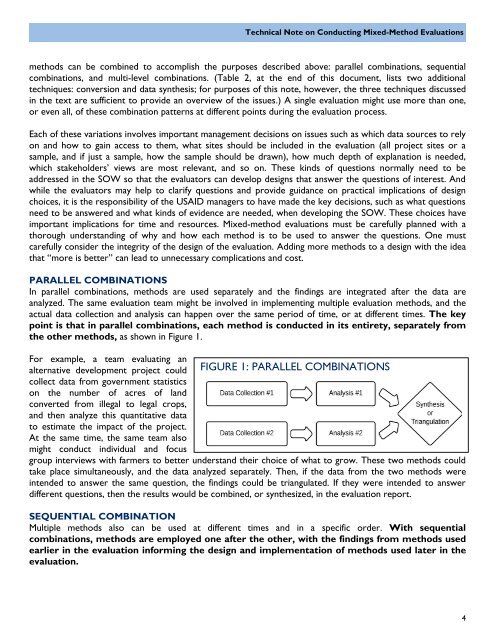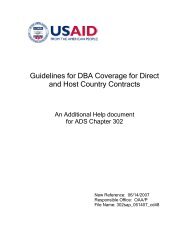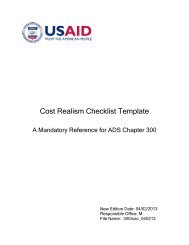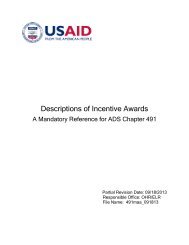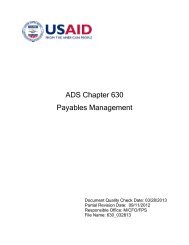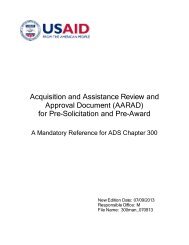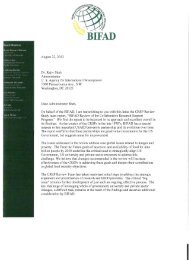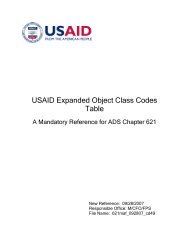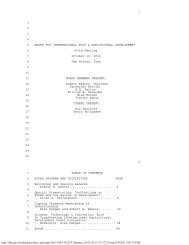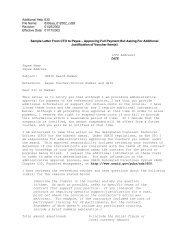Technical Note: Conducting Mixed Method Evaluations - usaid
Technical Note: Conducting Mixed Method Evaluations - usaid
Technical Note: Conducting Mixed Method Evaluations - usaid
You also want an ePaper? Increase the reach of your titles
YUMPU automatically turns print PDFs into web optimized ePapers that Google loves.
<strong>Technical</strong> <strong>Note</strong> on <strong>Conducting</strong> <strong>Mixed</strong>-<strong>Method</strong> <strong>Evaluations</strong><br />
methods can be combined to accomplish the purposes described above: parallel combinations, sequential<br />
combinations, and multi-level combinations. (Table 2, at the end of this document, lists two additional<br />
techniques: conversion and data synthesis; for purposes of this note, however, the three techniques discussed<br />
in the text are sufficient to provide an overview of the issues.) A single evaluation might use more than one,<br />
or even all, of these combination patterns at different points during the evaluation process.<br />
Each of these variations involves important management decisions on issues such as which data sources to rely<br />
on and how to gain access to them, what sites should be included in the evaluation (all project sites or a<br />
sample, and if just a sample, how the sample should be drawn), how much depth of explanation is needed,<br />
which stakeholders’ views are most relevant, and so on. These kinds of questions normally need to be<br />
addressed in the SOW so that the evaluators can develop designs that answer the questions of interest. And<br />
while the evaluators may help to clarify questions and provide guidance on practical implications of design<br />
choices, it is the responsibility of the USAID managers to have made the key decisions, such as what questions<br />
need to be answered and what kinds of evidence are needed, when developing the SOW. These choices have<br />
important implications for time and resources. <strong>Mixed</strong>-method evaluations must be carefully planned with a<br />
thorough understanding of why and how each method is to be used to answer the questions. One must<br />
carefully consider the integrity of the design of the evaluation. Adding more methods to a design with the idea<br />
that “more is better” can lead to unnecessary complications and cost.<br />
PARALLEL COMBINATIONS<br />
In parallel combinations, methods are used separately and the findings are integrated after the data are<br />
analyzed. The same evaluation team might be involved in implementing multiple evaluation methods, and the<br />
actual data collection and analysis can happen over the same period of time, or at different times. The key<br />
point is that in parallel combinations, each method is conducted in its entirety, separately from<br />
the other methods, as shown in Figure 1.<br />
For example, a team evaluating an<br />
alternative development project could FIGURE 1: PARALLEL COMBINATIONS<br />
collect data from government statistics<br />
on the number of acres of land<br />
converted from illegal to legal crops,<br />
and then analyze this quantitative data<br />
to estimate the impact of the project.<br />
At the same time, the same team also<br />
might conduct individual and focus<br />
group interviews with farmers to better understand their choice of what to grow. These two methods could<br />
take place simultaneously, and the data analyzed separately. Then, if the data from the two methods were<br />
intended to answer the same question, the findings could be triangulated. If they were intended to answer<br />
different questions, then the results would be combined, or synthesized, in the evaluation report.<br />
SEQUENTIAL COMBINATION<br />
Multiple methods also can be used at different times and in a specific order. With sequential<br />
combinations, methods are employed one after the other, with the findings from methods used<br />
earlier in the evaluation informing the design and implementation of methods used later in the<br />
evaluation.<br />
4


